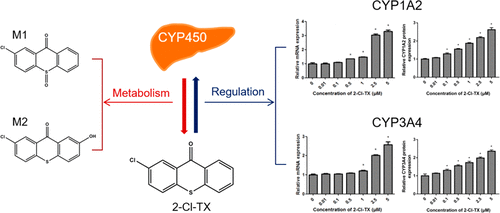当前位置:
X-MOL 学术
›
Environ. Sci. Technol.
›
论文详情
Our official English website, www.x-mol.net, welcomes your feedback! (Note: you will need to create a separate account there.)
Metabolic Susceptibility of 2-Chlorothioxanthone and Its Toxic Effects on mRNA and Protein Expression and Activities of Human CYP1A2 and CYP3A4 Enzymes
Environmental Science & Technology ( IF 10.8 ) Pub Date : 2018-10-03 , DOI: 10.1021/acs.est.8b04643 Tingjie Zhan 1 , Liumeng Pan 1 , Zhenfeng Liu 2 , Jiayan Chen 1 , Zhiwei Ge 3 , Liping Lu 1 , Xiaofang Zhang 1 , Shixuan Cui 1 , Chunlong Zhang 4 , Weiping Liu 1 , Shulin Zhuang 1
Environmental Science & Technology ( IF 10.8 ) Pub Date : 2018-10-03 , DOI: 10.1021/acs.est.8b04643 Tingjie Zhan 1 , Liumeng Pan 1 , Zhenfeng Liu 2 , Jiayan Chen 1 , Zhiwei Ge 3 , Liping Lu 1 , Xiaofang Zhang 1 , Shixuan Cui 1 , Chunlong Zhang 4 , Weiping Liu 1 , Shulin Zhuang 1
Affiliation

|
Thioxanthones (TXs) are photoinitiators widely used in UV curable resins and food packaging, and their residues have been frequently detected in human bodies. Our current understanding of the susceptibility of residual TXs to metabolism and their effects on human health is very limited. The in vitro metabolism of TXs and its toxic effects on cytochrome P450 (CYP) (the key xenobiotic metabolizing enzymes) were examined in this study. 2-Chlorothioxanthone (2-Cl-TX) significantly inhibited the enzymatic activities of CYP1A2 and CYP3A4 with IC50 of 8.36 and 0.86 μM, respectively. The exposure to 2-Cl-TX at 2.5 μM up-regulated the mRNA expression of CYP1A2 and CYP3A4 in human hepatocellular carcinoma cells to 3.03-fold and 2.02-fold, respectively. 2-Cl-TX at 2.5 μM caused 2.19-fold and 1.98-fold overexpression of CYP1A2 and CYP3A4, respectively. In vitro studies revealed that 2-Cl-TX was biotransformed into two metabolites through the sulfoxidation of the sulfur atom, or via the hydroxylation of aromatic carbon. Results from this study, including the metabolic susceptibility of residual 2-Cl-TX, the proposed metabolites and the significant toxic effect on the activities, mRNA, and protein expression of CYP1A2 and CYP3A4, are vital to the human health and safety risk assessment from this ubiquitous xenobiotic.
中文翻译:

2-氯噻吨酮的代谢敏感性及其对人CYP1A2和CYP3A4酶mRNA和蛋白表达及活性的毒理作用
噻吨酮(TXs)是在紫外线固化树脂和食品包装中广泛使用的光引发剂,它们的残留物在人体中经常被检测到。我们目前对残留TX对代谢的敏感性及其对人体健康的影响的理解非常有限。在这项研究中,研究了TXs的体外代谢及其对细胞色素P450(CYP)(主要的异源生物代谢酶)的毒性作用。2-氯噻吨酮(2-Cl-TX)显着抑制CYP1A2和CYP3A4的酶活性,IC 50分别为8.36和0.86μM。暴露于2.5μM的2-Cl-TX可使人肝癌细胞中CYP1A2和CYP3A4的mRNA表达分别上调3.03倍和2.02倍。2.5μM的2-Cl-TX分别导致CYP1A2和CYP3A4过量表达2.19倍和1.98倍。体外研究表明,2-Cl-TX通过硫原子的硫氧化或芳族碳的羟基化而生物转化为两种代谢物。这项研究的结果,包括残留的2-Cl-TX的代谢敏感性,拟议的代谢物以及对CYP1A2和CYP3A4的活性,mRNA和蛋白质表达的显着毒性作用,对人类健康和安全风险评估至关重要。这种无处不在的异生素。
更新日期:2018-10-03
中文翻译:

2-氯噻吨酮的代谢敏感性及其对人CYP1A2和CYP3A4酶mRNA和蛋白表达及活性的毒理作用
噻吨酮(TXs)是在紫外线固化树脂和食品包装中广泛使用的光引发剂,它们的残留物在人体中经常被检测到。我们目前对残留TX对代谢的敏感性及其对人体健康的影响的理解非常有限。在这项研究中,研究了TXs的体外代谢及其对细胞色素P450(CYP)(主要的异源生物代谢酶)的毒性作用。2-氯噻吨酮(2-Cl-TX)显着抑制CYP1A2和CYP3A4的酶活性,IC 50分别为8.36和0.86μM。暴露于2.5μM的2-Cl-TX可使人肝癌细胞中CYP1A2和CYP3A4的mRNA表达分别上调3.03倍和2.02倍。2.5μM的2-Cl-TX分别导致CYP1A2和CYP3A4过量表达2.19倍和1.98倍。体外研究表明,2-Cl-TX通过硫原子的硫氧化或芳族碳的羟基化而生物转化为两种代谢物。这项研究的结果,包括残留的2-Cl-TX的代谢敏感性,拟议的代谢物以及对CYP1A2和CYP3A4的活性,mRNA和蛋白质表达的显着毒性作用,对人类健康和安全风险评估至关重要。这种无处不在的异生素。








































 京公网安备 11010802027423号
京公网安备 11010802027423号